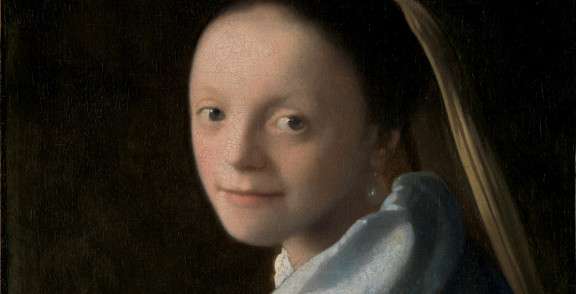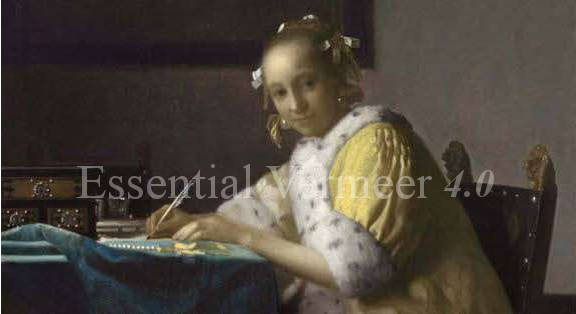Johan Larson - "a tronie, by Vermeer"
The sculptor Johan ("Jean") Larson at one time owned a so-called tronie by Vermeer which was valued at 10 guilders in his death inventory in 1664. The now defunct term tronie refers to "heads" or "faces" which had become familiar through Rembrandt and his followers. Even though the tronie represented a bust-length single figure, it is not a portrait in the true sense. Rather, the tronie presented the artist an opportunity to freely demonstrate his ability in rendering exotic costumes(fancy turbans or shining armor), particular lighting conditions or characteristic facial types. Vermeer's Girl in a Red Hat, Girl with a Flute Girl with a Pearl Earring and Study of a Young Woman can all be considered tronien, not portraits. The relatively low price of the Larson tronie is not surprising—even tronien by very popular Dutch masters, such as Rembrandt, fetched low prices.
Willem van Vliet
c. 1640
Oil on canvas, 65 x 57 cm.
Private Collection, New York
It is known that Larson had been in Delft on business in 1660. John Michael Montias supposed that he might have acquired the painting at that time, perhaps from Vermeer himself, although he does not believe it was the artist's iconic Girl with a Pearl Earring.
On the other hand, of the four known tronien by Vermeer the Girl with a Pearl Earring may have been particularly appealing to the tastes of a sculptor for its accentuated sense of volume and the expressive twisting of the head towards the spectator.
Johan Larson was born into a family of artists that was active in the first half of the seventeenth century in London and The Hague. Like their father Guillaume, Johan and his brother, Willem junior, became sculptors while the third brother, Dirck, became a painter. Given the name, the Larsons probably came from Sweden, although no clear traces of their origins have been found there.1
† FOOTNOTES †
- Frits Scholten, "The Larson Family of Statuary Founders: Seventeenth-Century Reproductive Sculpture for Gardens and Painters' Studios," Simiolus: Netherlands Quarterly for the History of Art vol. 31, no. 1/2, 2004–2005, 54.




 or anything else that isn't working as it should be, I'd love to hear it! Please write me at:
or anything else that isn't working as it should be, I'd love to hear it! Please write me at: